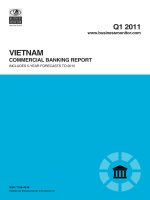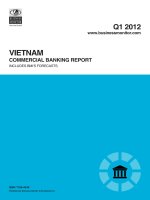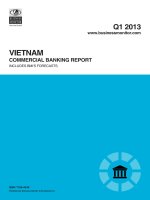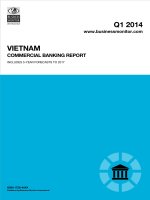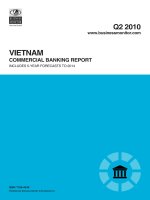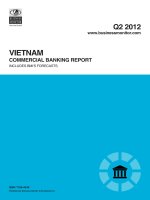Vietnam commercial banking report q3 2013
Bạn đang xem bản rút gọn của tài liệu. Xem và tải ngay bản đầy đủ của tài liệu tại đây (443.74 KB, 71 trang )
Q3 2013
www.businessmonitor.com
VIETNAM
COMMERCIAL BANKING REPORT
INCLUDES 5-YEAR FORECASTS TO 2017
ISSN 1758-454X
Published by:Business Monitor International
Vietnam Commercial Banking
Report Q3 2013
INCLUDES 5-YEAR FORECASTS TO 2017
Part of BMI’s Industry Report & Forecasts Series
Published by: Business Monitor International
Copy deadline: May 2013
Business Monitor International
Senator House
85 Queen Victoria Street
London
EC4V 4AB
United Kingdom
Tel: +44 (0) 20 7248 0468
Fax: +44 (0) 20 7248 0467
Email:
Web:
© 2013 Business Monitor International
All rights reserved.
All information contained in this publication is
copyrighted in the name of Business Monitor
International, and as such no part of this
publication may be reproduced, repackaged,
redistributed, resold in whole or in any part, or used
in any form or by any means graphic, electronic or
mechanical, including photocopying, recording,
taping, or by information storage or retrieval, or by
any other means, without the express written consent
of the publisher.
DISCLAIMER
All information contained in this publication has been researched and compiled from sources believed to be accurate and reliable at the time of
publishing. However, in view of the natural scope for human and/or mechanical error, either at source or during production, Business Monitor
International accepts no liability whatsoever for any loss or damage resulting from errors, inaccuracies or omissions affecting any part of the
publication. All information is provided without warranty, and Business Monitor International makes no representation of warranty of any kind as
to the accuracy or completeness of any information hereto contained.
CONTENTS
BMI Industry View 7
Table: Commercial Banking Sector Indicators 7
Table: Commercial Banking Sector Key Ratios, September 2012 7
Table: Annual Growth Rate Projections 2012-2017 (%) 7
Table: Ranking Out Of 62 Countries Reviewed In 2013 8
Table: Commercial Banking Sector Indicators, 2010-2017 8
SWOT 9
Commercial Banking 9
Political 10
Economic 11
Business Environment 12
Industry Forecast 13
Industry Risk Reward Ratings 16
Asia Commercial Banking Risk/Reward Ratings 16
Table: Asia Commercial Banking Business Environment Ratings 17
Market Overview 18
Asia Commercial Banking Outlook 18
Table: Banks' Bond Portfolios, 2012 18
Table: Comparison of Loan/Deposit & Loan/Asset & Loan/GDP ratios, 2013 18
Table: Comparison of Total Assets & Client Loans & Client Deposits (US$bn) 19
Table: Comparison of US$ Per Capita Deposits, 2013 20
Economic Outlook 20
Table: Vietnam - Economic Activity 24
Competitive Landscape 25
Market Structure 25
Protagonists 25
Table: Protagonists In Vietnam's Commercial Banking Sector 25
Definition Of The Commercial Banking Universe 25
List Of Banks 26
Table: Financial Institutions In Vietnam 26
Company Profile 29
Bank for Foreign Trade of Vietnam (Vietcombank) 29
Table: Stock Market Indicator 31
Table: Balance Sheet (VNDmn) 31
Table: Balance Sheet (US$mn) 31
Table: Key Ratios (%) 32
VietinBank 33
Table: Stock Market Indicators 35
Vietnam Commercial Banking Report Q3 2013
© Business Monitor International Page 4
Table: Balance Sheet (VNDmn) 35
Table: Balance Sheet (US$mn) 35
Table: Key Ratios (%) 36
Agribank 37
Table: Balance Sheet (VNDmn) 38
Table: Balance Sheet (US$mn) 39
Table: Key Ratios (%) 39
Asia Commercial Bank 40
Table: Stock Market Indicators 41
Table: Balance Sheet (VNDmn) 42
Table: Balance Sheet (US$mn) 42
Table: Key Ratios (%) 42
Eximbank 43
Table: Stock Market Indicators 44
Table: Balance Sheet (VNDmn) 45
Table: Balance Sheet (US$mn) 45
Table: Key Ratios (%) 45
Housing Development Commercial Joint Stock Bank (HDBank) 46
Sacombank 48
Table: Stock Market Indicators 50
Table: Balance Sheet (VNDmn) 50
Table: Balance Sheet (US$mn) 51
Table: Key Ratios (%) 51
Regional Overview 52
Asia Overview 52
Financial Market Reforms A Crucial Element In Attracting FDI 53
Playing Catch-Up 54
Regional Integration To Spur Expansion 55
Global Industry Overview 57
Global Commercial Banking Outlook 57
Emerging Market Regional Outlooks 60
Demographic Forecast 63
Table: Vietnam's Population By Age Group, 1990-2020 ('000) 64
Table: Vietnam's Population By Age Group, 1990-2020 (% of total) 65
Table: Vietnam's Key Population Ratios, 1990-2020 66
Table: Vietnam's Rural And Urban Population, 1990-2020 66
Methodology 67
Table: Commercial Banking Risk/Reward Rating Indicators And Rationale 69
Table: Weighting Of Indicators 70
Vietnam Commercial Banking Report Q3 2013
© Business Monitor International Page 5
BMI Industry View
Table: Commercial Banking Sector Indicators
Date
Total
assets
Client
loans
Bond
portfolio Other
Liabilities
and
capital Capital
Client
deposits Other
September 2011, VNDbn 3,211,099 2,688,670 249,530 272,899 3,211,099 517,722 2,436,825 256,552
September 2012, VNDbn 3,643,387 2,909,510 340,971 392,906 3,643,387 579,893 2,812,749 250,745
% change y-o-y 13.5% 8.2% 36.6% 44.0% 13.5% 12.0% 15.4% -2.3%
September 2011, US$bn 154.2 129.1 12.0 13.1 154.2 24.9 117.0 12.3
September 2012, US$bn 174.6 139.4 16.3 18.8 174.6 27.8 134.8 12.0
% change y-o-y 13.3% 8.0% 36.4% 43.7% 13.3% 11.8% 15.2% -2.4%
Source: BMI; Central banks; Regulators
Table: Commercial Banking Sector Key Ratios, September 2012
Loan/
deposit ratio
Loan/
asset ratio
Loan/
GDP ratio
GDP Per
Capita, US$
Deposits per
Capita, US$
103.44% 79.86% n.a. 1,072.1 1,506.3
Falling Falling Falling n.a. n.a.
Source: BMI; Central banks; Regulators
Table: Annual Growth Rate Projections 2012-2017 (%)
Assets Loans Deposits
Annual Growth Rate 11 9 6
CAGR 13 11 8
Ranking 16 23 34
Source: BMI; Central banks; Regulators
Vietnam Commercial Banking Report Q3 2013
© Business Monitor International Page 7
Table: Ranking Out Of 62 Countries Reviewed In 2013
Loan/deposit ratio Loan/asset ratio Loan/GDP ratio
9 1 17
Local currency asset growth Local currency loan growth Local currency deposit growth
15 18 23
Source: BMI; Central banks; Regulators
Table: Commercial Banking Sector Indicators, 2010-2017
2010 2011 2012e 2013f 2014f 2015f 2016f 2017f
Total assets, VNDbn 2,953,153 3,437,893 3,816,061 4,350,310 4,959,353 5,604,069 6,276,557 6,966,979
Total assets, US$bn 151.5 163.4 183.1 208.1 241.2 275.7 312.3 348.3
Client loans, VNDbn 2,475,540 2,829,890 3,084,580 3,454,730 3,869,297 4,294,920 4,724,412 5,149,609
Client loans, US$bn 127.0 134.5 148.0 165.3 188.1 211.3 235.0 257.5
Client deposits, VNDbn 2,209,896 2,483,357 2,706,859 2,977,545 3,245,524 3,505,166 3,750,528 3,975,560
Client deposits, US$bn 113.3 118.1 129.9 142.5 157.8 172.4 186.6 198.8
e/f = estimate/forecast. Source: BMI; Central banks; Regulators
Vietnam Commercial Banking Report Q3 2013
© Business Monitor International Page 8
SWOT
Commercial Banking
Vietnam Commercial Banking SWOT
Strengths
■
Untapped market with potential for increased participation of foreign banks.
■
Large population with a high savings rate and potential for income growth.
■
The Vietnamese government aims to speed up the process of privatising state-owned
banks, which will help modernise the industry.
■
State-owned banks will play a lesser role going forward, and the risks associated with
state-directed lending will decrease over time.
Weaknesses
■
Domestic banks continue to lag behind their foreign peers in terms of financial
strength and the technological curve.
■
Accounting standards lag far behind international standards and the lack of
transparency entails significant risks for foreign investors.
■
Small banks have an overwhelming exposure to real estate and individual loans,
resulting in highly skewed and risky loan portfolios.
Opportunities
■
The population is still underbanked, with significant potential for adopting cash-free
payment systems and new mobile banking technologies.
■
Rising income levels and deepening capital markets could give rise to opportunities in
more sophisticated financial products and growth for the local asset management
industry.
Threats
■
Track record of macroeconomic instability threatens the credibility of the government
and could potentially drive economic policy away from further liberalisation.
■
The high level of government debt risks triggering a fiscal crisis, undermining
confidence in the banking sector.
Vietnam Commercial Banking Report Q3 2013
© Business Monitor International Page 9
Political
SWOT Analysis
Strengths
■
The Communist Party of Vietnam remains committed to market-oriented reforms and
we do not expect major shifts in policy direction over the next five years. The one-
party system is generally conducive to short-term political stability.
■
Relations with the US have witnessed a marked improvement, and Washington sees
Hanoi as a potential geopolitical ally in South East Asia.
Weaknesses
■
Corruption among government officials poses a major threat to the legitimacy of the
ruling Communist Party.
■
There is increasing (albeit still limited) public dissatisfaction with the leadership's tight
control over political dissent.
Opportunities
■
The government recognises the threat corruption poses to its legitimacy, and has
acted to clamp down on graft among party officials.
■
Vietnam has allowed legislators to become more vocal in criticising government
policies. This is opening up opportunities for more checks and balances within the
one-party system.
Threats
■
Macroeconomic instabilities in 2012 are likely to weigh on public acceptance of the
one-party system, and street demonstrations to protest economic conditions could
develop into a full-on challenge of undemocractic rule.
■
Although strong domestic control will ensure little change to Vietnam's political scene
in the next few years, over the longer term, the one-party-state will probably be
unsustainable.
■
Relations with China have deteriorated over recent years due to Beijing's more
assertive stance over disputed islands in the South China Sea and domestic criticism
of a large Chinese investment into a bauxite mining project in the central highlands,
which could potentially cause wide-scale environmental damage.
Vietnam Commercial Banking Report Q3 2013
© Business Monitor International Page 10
Economic
SWOT Analysis
Strengths
■
Vietnam has been one of the fastest-growing economies in Asia in recent years, with
GDP growth averaging 7.1% annually between 2000 and 2012.
■
The economic boom has lifted many Vietnamese out of poverty, with the official
poverty rate in the country falling from 58% in 1993 to 14.0% in 2010.
Weaknesses
■
Vietnam still suffers from substantial trade, current account and fiscal deficits, leaving
the economy vulnerable to global economic uncertainties in 2012. The fiscal deficit is
dominated by substantial spending on social subsidies that could be difficult to
withdraw.
■
The heavily-managed and weak currency reduces incentives to improve quality of
exports, and also keeps import costs high, contributing to inflationary pressures.
Opportunities
■
WTO membership has given Vietnam access to both foreign markets and capital,
while making Vietnamese enterprises stronger through increased competition.
■
The government will in spite of the current macroeconomic woes, continue to move
forward with market reforms, including privatisation of state-owned enterprises, and
liberalising the banking sector.
■
Urbanisation will continue to be a long-term growth driver. The UN forecasts the
urban population rising from 29% of the population to more than 50% by the early
2040s.
Threats
■
Inflation and deficit concerns have caused some investors to re-assess their hitherto
upbeat view of Vietnam. If the government focuses too much on stimulating growth
and fails to root out inflationary pressure, it risks prolonging macroeconomic
instability, which could lead to a potential crisis.
■
Prolonged macroeconomic instability could prompt the authorities to put reforms on
hold as they struggle to stabilise the economy.
Vietnam Commercial Banking Report Q3 2013
© Business Monitor International Page 11
Business Environment
SWOT Analysis
Strengths
■
Vietnam has a large, skilled and low-cost workforce, which has made the country
attractive to foreign investors.
■
Vietnam's location - its proximity to China and South East Asia, and its good sea links
- makes it a good base for foreign companies to export to the rest of Asia, and
beyond.
Weaknesses
■
Vietnam's infrastructure is still weak. Roads, railways and ports are inadequate to
cope with the country's economic growth and links with the outside world.
■
Vietnam remains one of the world's most corrupt countries. According to
Transparency International's 2012 Corruption Perceptions Index, Vietnam ranks 123
out of 176 countries.
Opportunities
■
Vietnam is increasingly attracting investment from key Asian economies, such as
Japan, South Korea and Taiwan. This offers the possibility of the transfer of high-tech
skills and know-how.
■
Vietnam is pressing ahead with the privatisation of state-owned enterprises and the
liberalisation of the banking sector. This should offer foreign investors new entry
points.
Threats
■
Ongoing trade disputes with the US, and the general threat of American
protectionism, which will remain a concern.
■
Labour unrest remains a lingering threat. A failure by the authorities to boost skills
levels could leave Vietnam a second-rate economy for an indefinite period.
Vietnam Commercial Banking Report Q3 2013
© Business Monitor International Page 12
Industry Forecast
BMI View: The establishment of a new debt management agency should help to restart lending in the
banking sector in our view. However, we see increasing risks that state-directed lending in the property
sector could result in a rise in non-performing loans (NPLs) going forward, creating further downside risks
to our already weak outlook on the banking sector and the property market in 2013 and 2014.
The Vietnamese government is scheduled to order ailing banks to offload non-performing debt on their
balance sheets to a newly established debt management agency by July, a move that we believe will play a
crucial role in reinforcing existing efforts to reignite credit growth. The highly anticipated move is also part
of a broader plan aimed at restructuring and reinstalling confidence in the banking system, and has
repeatedly been cited by international observers as a prerequisite for a robust economic recovery. At the
very least, we expect the debt management agency's aim to clean up the balance sheets of local banks to
help free up funds, and this should allow the banking sector to restart lending to businesses.
Struggling To Reignite Credit
Vietnam - Outstanding Loans, VNDtrn (LHS) & % chg y-o-y (RHS)
Source: BMI, IMF/IFS (estimates from October 2012 onwards)
Vietnam Commercial Banking Report Q3 2013
© Business Monitor International Page 13
According to State Bank of Vietnam (SBV) Chief Inspector Nguyen Huu Nghia, banks with nonperforming
loans (NPLs) of 3.0% and above based on the central bank's assessment will be ordered to comply with the
directive. He added that the directive has been finalised and is pending the approval of Prime Minister
Nguyen Tan Dung, with the newly established asset management company expected to have an initial
registered capital of VND500bn (US$24mn). We also believe that the directive may order small ailing
banks to be merged with larger state-owned banks, as part of the government's plan to reduce the number of
local banks in Vietnam from around 39 currently to 20 by 2015.
Still A Long Way To Go
Vietnam - Number Of Banks By Category
Source: BMI, State Bank of Vietnam
A Painful Lesson From State-Directed Lending
From a long-term perspective, we see an urgent need for the Vietnamese government to allow the banking
sector to function freely based on market forces and refrain from state-directed lending. Indeed, we view the
practice of providing state-directed loans at preferential interest rates to state-owned enterprises (SOEs) as a
key factor that contributed to the rise in NPLs and the build-up of bad debt across the banking sector over
the years. Although efforts by the government to speed up the process of privatising SOEs suggest that the
Vietnam Commercial Banking Report Q3 2013
© Business Monitor International Page 14
role of state-directed lending will become redundant over time, we note that progress on this front remains
slow.
It also appears to us that the Vietnamese government has yet to appreciate the painful lessons of its
misguided policies on state-directed lending, which have failed so miserably over the years. In an attempt to
reignite growth in the property sector, the government announced that it is directing VND30trn (US$1.4bn)
in new loans for home buyers and property developers effective June 1. The new loans will be issued at
preferential rates, estimated to be half that of the average lending rate on regular loans (average lending
rates stand at around 12.2% as of March). Although these loans are targeted solely at housing projects to
provide social housing for lower-income groups, we nonetheless believe that the policy risks creating highly
distorted incentives for the property sector. The policy is also counterintuitive to the government's goal to
address high NPLs across the banking sector as such loans risk increasing NPLs in the future due to their
higher risk profile, and without compensating banks with higher yields. We see a need for the government
to withdraw these loans as the economy gradually improves.
For now, the implementation of the policy is likely to create further downside risks to our already weak
outlook on the banking sector and the property market in 2013 and 2014. What is more, the Vietnamese
government is likely to foot the bill should these loans fail to be paid back overtime. Such a scenario would
risk placing significant pressure on the government's finances, undermining efforts to address Vietnam's
deteriorating fiscal position over the longer term, with the country already holding a relatively poor rating of
D+ in our proprietary sovereign risk ratings.
Vietnam Commercial Banking Report Q3 2013
© Business Monitor International Page 15
Industry Risk Reward Ratings
Asia Commercial Banking Risk/Reward Ratings
Business Environment Rating Methodology
Since Q108, we have described numerically the banking business environment for each of the countries
surveyed by BMI. We do this through our Commercial Banking Business Environment Rating (CBBER), a
measure that ensures we capture the latest quantitative information available. It also ensures consistency
across all countries and between the inputs to the CBBER and the Insurance Business Environment Rating,
which is likewise now a feature of our insurance reports. Like the Business Environment Ratings calculated
by BMI for all the other industries on which it reports, the CBBER takes into account the limits of potential
returns and the risks to the realisation of those returns. It is weighted 70% to the former and 30% to the
latter.
The evaluation of the 'Limits of potential returns' includes market elements that are specific to the banking
industry of the country in question and elements that relate to that country in general. Within the 70% of the
CBBER that takes into account the 'Limits of potential returns', the market elements have a 60% weighting
and the country elements have a 40% weighting. The evaluation of the 'Risks to realisation of returns' also
includes banking elements and country elements (specifically, BMI's assessment of long-term country risk).
However, within the 30% of the CBBER that take into account the risks, these elements are weighted 40%
and 60%, respectively.
Further details on how we calculate the CBBER are provided at the end of this report. In general, though,
three aspects need to be borne in mind in interpreting the CBBERs. The first is that the market elements of
the 'Limits of potential returns' are by far the most heavily weighted of the four elements. They account for
60% of 70% (or 42%) of the overall CBBER. Second, if the market elements are significantly higher than
the country elements of the 'Limits of potential returns', it usually implies that the banking sector is (very)
large and/or developed relative to the general wealth, stability and financial infrastructure in the country.
Conversely, if the market elements are significantly lower than the country elements, it usually means that
the banking sector is small and/or underdeveloped relative to the general wealth, stability and financial
infrastructure in the country. Third, within the 'Risks to the realisation of returns' category, the market
elements (i.e. how regulations affect the development of the sector, how regulations affect competition
within it, and Moody's Investor Services' ratings for local currency deposits) can be markedly different from
BMI's long-term risk rating.
Vietnam Commercial Banking Report Q3 2013
© Business Monitor International Page 16
Table: Asia Commercial Banking Business Environment Ratings
Limits of Potential Returns Risks to Potential Returns Overall
Market Structure Country Structure Market Risks Country Risks Rating Ranking
Bangladesh 50.0 45.0 43.3 44.0 46.7 56
China 93.3 57.5 63.3 74.0 76.2 15
Hong Kong 80.0 92.5 73.3 78.0 82.3 7
India 83.3 57.5 60.0 54.0 68.0 30
Indonesia 76.7 65.0 80.0 52.0 69.4 28
Japan 33.3 77.5 66.7 80.0 58.1 36
Malaysia 73.3 80.0 83.3 80.0 77.6 12
Pakistan 46.7 50.0 53.3 42.0 47.6 54
Philippines 50.0 62.5 60.0 58.0 56.1 42
Singapore 66.7 95.0 96.7 90.0 82.4 6
Sri Lanka 30.0 55.0 33.3 46.0 40.3 59
South Korea 80.0 85.0 83.3 76.0 81.1 8
Taiwan 76.7 72.5 86.7 76.0 76.6 14
Thailand 66.7 65.0 86.7 74.0 69.9 24
Vietnam 60.0 55.0 36.7 48.0 53.6 47
United States 93.3 85.0 100.0 80.0 89.4 2
Scores out of 100, with 100 the highest. Source: BMI
Vietnam Commercial Banking Report Q3 2013
© Business Monitor International Page 17
Market Overview
Asia Commercial Banking Outlook
Table: Banks' Bond Portfolios, 2012
Bond Portfolio, US$bn Bond as % total assets Year-on-year growth %
Bangladesh* 17.1 23.0 19.3
China 1,833.1 8.5 15.0
Hong Kong 379.3 19.8 8.1
India 352.2 26.5 14.3
Indonesia* 17.3 4.3 17.7
Japan 3,123.6 30.7 3.4
Malaysia 87.4 14.5 24.3
Pakistan 41.5 42.9 33.7
Philippines* 35.4 23.7 -4.3
Singapore* 76.5 11.6 5.5
Sri Lanka 5.1 17.0 25.5
South Korea* 271.5 17.0 4.6
Taiwan* 98.0 8.4 -47.2
Thailand 82.1 17.0 21.4
Vietnam* 12.3 7.5 27.0
United States 535.0 4.0 19.7
Source: BMI, Central banks, regulators. *Only 2011 data available
Table: Comparison of Loan/Deposit & Loan/Asset & Loan/GDP ratios, 2013
Loan/
Deposit ratio
% Rank Trend
Loan/Asset
ratio % Rank Trend
Loan/GDP
ratio % Rank Trend
Bangladesh 91.4 34 Falling 67.1 12 Falling 53.6 42 Rising
China 74.9 52 Rising 50.8 42 Falling 124.7 10 Falling
Hong Kong 67.7 58 Rising 37.8 56 Rising 270.9 2 Rising
India 78.9 50 Rising 68.8 8 Rising 57.2 41 Rising
Indonesia 83.3 43 Rising 62.5 17 Rising 34.8 52 Rising
Japan 69.8 57 Falling 48.0 44 Falling 91.8 19 Rising
Malaysia 79.0 46 Rising 59.4 31 Rising 120.9 12 Rising
Vietnam Commercial Banking Report Q3 2013
© Business Monitor International Page 18
Comparison of Loan/Deposit & Loan/Asset & Loan/GDP ratios, 2013 - Continued
Loan/
Deposit ratio
% Rank Trend
Loan/Asset
ratio % Rank Trend
Loan/GDP
ratio % Rank Trend
Pakistan 61.9 59 Falling 43.3 50 Falling 21.2 58 Falling
Philippines 76.9 56 Rising 56.8 39 Rising 36.6 50 Rising
Singapore 92.0 30 Rising 52.3 40 Rising 134.7 8 Rising
Sri Lanka 83.8 45 Rising 60.4 29 Falling 31.5 53 Rising
South Korea 114.4 11 Falling 72.0 7 Rising 103.5 15 Falling
Taiwan 80.7 48 Rising 63.8 21 Rising 165.5 5 Rising
Thailand 98.1 31 Falling 66.4 13 Rising 85.5 22 Rising
Vietnam 116.0 13 Rising 79.4 1 Falling 103.5 14 Falling
United States 103.8 17 Falling 75.6 3 Rising 63.9 33 Rising
Source: BMI, Central banks, regulators
Table: Comparison of Total Assets & Client Loans & Client Deposits (US$bn)
2013 2012
Total Assets Client Loans Client Deposits Total Assets Client Loans Client Deposits
Bangladesh 111.1 74.6 81.6 88.9 59.7 64.5
China 22,342.2 11,349.2 15,143.8 21,549.8 10,740.2 14,197.2
Hong Kong 2,046.1 774.1 1,142.6 1,917.2 718.6 1,070.6
India 1,685.2 1,159.3 1,468.4 1,327.9 913.5 1,176.7
Indonesia 521.9 326.0 391.6 435.3 276.5 329.3
Japan 9,932.1 4,766.1 6,826.5 10,179.4 4,975.1 7,091.4
Malaysia 700.6 416.4 527.1 604.0 359.0 450.3
Pakistan 107.4 46.5 73.2 96.6 44.0 66.6
Philippines 181.0 102.7 133.7 170.4 91.2 125.3
Singapore 766.0 401.0 436.0 741.5 395.7 404.5
Sri Lanka 36.9 22.3 26.6 29.9 18.1 21.9
South Korea 1,710.1 1,231.7 1,076.7 1,798.8 1,295.6 1,112.3
Taiwan 1,316.4 840.1 1,040.5 1,264.4 787.9 999.3
Thailand 520.5 345.5 352.3 483.0 319.1 326.9
Vietnam 208.1 165.3 142.5 183.1 148.0 129.9
Vietnam Commercial Banking Report Q3 2013
© Business Monitor International Page 19
Comparison of Total Assets & Client Loans & Client Deposits (US$bn) - Continued
2013 2012
United States 14,025.2 10,603.8 10,212.0 13,231.3 10,003.5 9,283.6
Source: BMI, Central banks, regulators
Table: Comparison of US$ Per Capita Deposits, 2013
GDP Per
Capita
Client Deposits,
per capita
Rich 20% Client Deposits, per
capita
Poor 80% Client Deposits, per
capita
Bangladesh 850 483 2,114 132
China 6,752 8,349 44,561 2,785
Hong Kong 39,277 106,415 628,287 39,268
India 1,589 909 4,606 288
Indonesia 3,811 1,319 6,337 396
Japan 41,985 37,723 216,122 13,508
Malaysia 11,365 13,979 70,783 4,424
Pakistan 1,229 254 1,599 100
Philippines 2,876 1,047 5,450 341
Singapore 54,857 73,900 321,439 20,090
Sri Lanka 3,244 1,040 4,966 310
South Korea 24,832 25,253 88,296 5,518
Taiwan 21,563 36,059 178,643 11,165
Thailand 5,840 4,991 20,357 1,272
Vietnam 1,762 1,823 6,286 393
United States 52,132 33,293 128,252 8,016
Source: BMI, Central banks, regulators
Economic Outlook
BMI View: The State Bank of Vietnam's surprise decision to cut its policy rate by 100 basis points from
10.00% to 9.00% suggests that policymakers are under increasing pressure to stimulate economic growth
in 2013. We believe that the latest move will help reinforce government efforts to boost private sector
investment. Given that money supply growth remains considerably low by historical standards, we believe
that the risks of reigniting inflationary pressure remain manageable.
Vietnam Commercial Banking Report Q3 2013
© Business Monitor International Page 20
The State Bank of Vietnam (SBV) cut its policy rate (refinancing rate) by 100 basis points from 10.00% to
9.00% on December 24 2012, just days before the General Statistics Office published its preliminary
estimate for GDP growth to come in slightly weaker than expected at 5.0% for 2012 (compared
with Bloomberg consensus of 5.2%). The surprise rate cut came amid growing concerns that mounting bad
debt across the banking sector is deterring banks from issuing new loans to businesses, and that this could
severely undermine government efforts to reignite economic growth in 2013. From our perspective, the
move also suggests that policymakers are under increasing pressure to adopt more aggressive measures to
stimulate economic growth in an attempt to stem the growing number of bankruptcies among small-and-
medium enterprises (SMEs) and rising unemployment. This is closely in line with our view that the
Vietnamese government's economic agenda will remain skewed towards boosting growth in 2013.
Recovery On Track
Vietnam - Real GDP, VNDbn (LHS) & % chg y-o-y (RHS)
Source: BMI, General Statistics Office
We are seeing evidence that credit conditions are beginning to improve and expect demand for private
sector credit to pick up gradually in H113. In addition to aggressive monetary policy easing by the SBV, the
government has also announced plans to slash corporate income tax rates by two percentage points to 23%
Vietnam Commercial Banking Report Q3 2013
© Business Monitor International Page 21
in 2013. We believe that lower lending rates and tax incentives will help to reinforce government efforts to
attract foreign direct investment and boost private sector investment over the coming quarters.
Inflation Still A Manageable Risk
International organisations including the World Bank and IMF have warned against easing monetary policy
too aggressively, which risks reigniting inflationary pressure. Although we acknowledge these risks, we
highlight that the recent rebound in money supply growth remains considerably weak by historical
standards. As the accompanying chart shows, prior to periods in which Vietnam experienced very high
inflation (2008 and 2011), M2 money supply was expanding at a rate of 33.3% and 46.1% in 2007 and
2010, respectively. This compares with M2 growth that came in at a record low of just 6.0% in 2012 and
our forecast for a mild pickup towards 11.0% for 2013, suggesting that inflation is likely to remain
manageable at under 7.0% in 2013.
Credit Conditions To Improve In 2013
Vietnam - M2 Money Supply, VNDbn (LHS) & % chg y-o-y (RHS)
f = BMI forecast. Source: BMI, State Bank of Vietnam
We acknowledge that the risk of a potential surge in commodity prices in 2013 - especially food prices,
which make up around 40% of the consumer price index basket - could turn out to be a wildcard for
Vietnam Commercial Banking Report Q3 2013
© Business Monitor International Page 22
policymakers. For now, we believe that overall conditions in Vietnam remain in favour of our forecast for
real GDP growth to come in relatively strong at 7.0% in 2013.
Expenditure Breakdown
Private Consumption: We expect private consumption to grow at a robust pace of 5.6% in 2013. However,
we note that the risk of a sustained collapse in exports and further bankruptcies among SMEs could
potentially lead to widespread job losses in export-driven sectors. Uncertainties over the outlook for
employment could, in turn, prompt households to cut back on spending.
Gross Fixed Capital Formation: We foresee a significant pickup in private sector investment growth in
2013. We believe lending rates will gradually ease over the coming months as the effect of recent rate cuts
by the SBV begins to kick in. We are also seeing evidence that credit conditions are improving.
Accordingly, we expect gross fixed capital formation growth to accelerate from 4.3% in 2012 to 5.9% in
2013.
Public Spending: We expect total public spending to remain relatively resilient in 2013, expanding at a
respectable pace of 5.4%. However, there is limited room for the government to increase spending further
owing to concerns over the need to finance a potential bailout of ailing state-owned commercial banks.
Net Exports: Net exports remain the biggest downside risk to our outlook for the Vietnamese economy,
although we expect external demand to pick up as we head into H113. Vietnam has been recording an
average monthly trade surplus of US$172mn since June 2012 (resulting in a year-to-date surplus of US
$77mn) and we see the case for a substantial pickup in external demand on the back of a rebound in
regional growth over the coming month. However, we believe that China's structural imbalances will return
in H213, becoming a drag on regional growth. Accordingly, we still expect exports to expand at a moderate
pace of 6.5% in 2013.
Vietnam Commercial Banking Report Q3 2013
© Business Monitor International Page 23
Table: Vietnam - Economic Activity
2009 2010 2011e 2012e 2013f 2014f 2015f 2016f 2017f
Nominal GDP,
VNDbn
2
1,658,389 1,980,914 2,536,631 2,950,684 3,361,036 3,813,158 4,301,043 4,832,660 5,422,488
Nominal GDP,
US$bn
2
93.16 103.53 122.82 141.44 161.59 185.42 211.56 240.43 271.12
Real GDP
growth, %
change y-o-y
2
5.3 6.8 6.0 5.0 7.0 7.2 7.2 7.0 6.9
GDP per capita,
US$
2
1,072 1,178 1,383 1,576 1,782 2,025 2,289 2,577 2,881
Population, mn
3
86.9 87.8 88.8 89.7 90.7 91.6 92.4 93.3 94.1
Industrial
production
index, % y-o-y,
ave
1,4
6.7 14.1 10.9 7.0 12.0 14.0 13.0 12.0 11.0
Unemployment,
% of labour
force, eop
4
6.0 4.3 4.5 6.0 4.8 4.7 4.6 4.5 4.4
Notes:
e
BMI estimates.
f
BMI forecasts.
1
at 1994 prices. Sources:
2
Asian Development Bank, General Statistics Office;
3
World Bank/UN/BMI;
4
General Statistics Office.
Vietnam Commercial Banking Report Q3 2013
© Business Monitor International Page 24
Competitive Landscape
Market Structure
Protagonists
Table: Protagonists In Vietnam's Commercial Banking Sector
Central bank: State Bank of Vietnam (SBV)
www.sbv.gov.vn/en/home
The SBV is the successor to the Vietnam National Bank, which was established by the government of North Vietnam in
1951. From 1975 to May 1990, the SBV was the banking system of Vietnam. The government then established the 'two-
tier' system that is still in place. The financial liberalisation at the beginning of the 1990s lead to the establishment of four
large state-owned commercial banks: Agribank, BIDV, Incombank and Vietcombank. This period also included the
establishment of commercial joint-stock banks, joint-venture banks, branches or representative offices of foreign banks,
credit cooperatives, people's credit funds and finance companies.
The SBV implements the state management of currency trading, credit, payment, foreign exchange and banking; is the
only bank authorised to issues bank notes; and acts as the bank to the banks and the state. The central bank organises
the management of monetary policy and ensuring a stable currency value is its main objective.
Principal banking regulator: State Bank of Vietnam (SBV)
www.sbv.gov.vn/en/home
Among its other functions, the SBV is the regulator of the banking system.
Banking trade association: Vietnam Bankers Association (VNBA)
www.vnbaorg.info
The VNBA was founded in 1994 and became a part of the ASEAN Bankers Association the following year, after
Vietnam's accession to association. The functions of the VNBA are: to act as a link between the banks and the
authorities, including dissemination of 'the policies, mechanisms and laws on banking operations' to its members;
protecting the interests of the members; training and research; and expansion of international cooperation.
Definition Of The Commercial Banking Universe
The State Bank of Vietnam identifies six 'state-owned credit institutions' or 'state-owned commercial banks'
(SOCBs), 38 urban commercial joint stock banks (CJSBs), 32 branches of foreign banks and five joint
venture banks. There are also 17 finance companies and 54 representative offices of foreign banks. In terms
of the numbers of branches, VietinBank is the largest organisation, with a presence at 138 locations. The
other SOCBs also have large networks by local standards. Agribank has 115; BIDV, 103; VBSP, 65; VDB,
62; and MDHDB, 32. Of the urban CJSBs, the organisations which have over 25 branches are:
Maritime CJSB (26); Techcombank (38); VIB (42); Sacombank (59); Vietcombank (59); Eximbank
(35); Military Bank (36); ACB (54); Saigonbank (31); VP Bank (34); and EAB (28). None of the joint-
venture banks have more than five branches.
Vietnam Commercial Banking Report Q3 2013
© Business Monitor International Page 25

